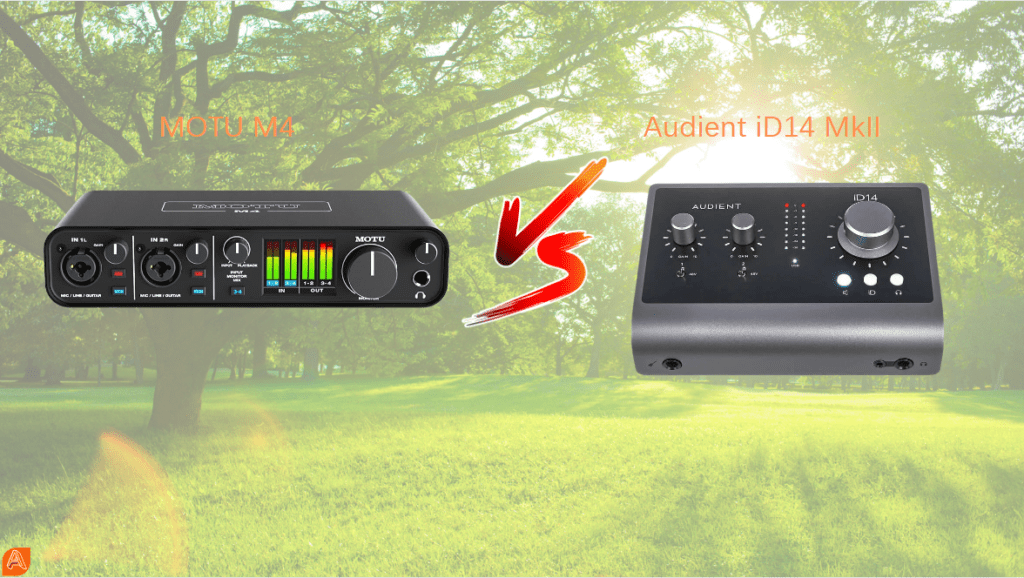MOTU M4 vs. Audient iD14 MkII Comparison review

The comparison
In the dynamic world of home studio recording, the MOTU M4 and Audient iD14 MkII stand out as top contenders. The MOTU M4 dazzles with its ESS Sabre32 Ultra™ DAC technology, offering exceptional clarity and depth, while the Audient iD14 MkII shines with its renowned Audient Console mic preamps, delivering warm, professional-grade sound. Both interfaces combine modern functionality with high-quality audio, making them essential tools for musicians and producers seeking excellence in their recordings.
MOTU M4
Sound Quality
Preamp Quality: Features ESS Sabre32 Ultra™ DAC technology for clean and transparent sound.
AD/DA Conversion: High-quality converters provide clear and accurate audio reproduction.
Noise Floor: Low noise floor ensures minimal background noise in recordings.
Connectivity Options
Inputs/Outputs: 4-in/4-out configuration, including two mic inputs with preamps, two balanced line outputs, and MIDI I/O.
Connection Type: USB-C for fast and reliable data transfer.
Phantom Power: Available for both mic inputs.
Build Quality and Portability
Durability: Solid metal chassis, ensuring longevity and durability.
Size/Weight: Compact and portable, ideal for mobile recording setups.
Controls: User-friendly interface with clearly labeled controls.
Latency and Performance
Latency: Low latency performance, suitable for real-time monitoring.
Driver Stability: Reliable drivers with stable performance across various operating systems.
Buffer Size/Sample Rate: Supports buffer sizes down to 32 samples and sample rates up to 192 kHz.
Software and Compatibility
Bundled Software: Comes with MOTU Performer Lite and various virtual instruments.
Updates: Regular driver and firmware updates.
Compatibility: Compatible with Windows, macOS, and major DAWs.
Pros and Cons
Pros:
- Excellent AD/DA conversion
- MIDI I/O
- Compact and durable design
Cons:
- Fewer input channels compared to iD14 MkII
- Slightly less known brand in some regions
Audient iD14 MkII
Sound Quality
Preamp Quality: Equipped with two Audient Console mic preamps, renowned for their professional-grade quality.
AD/DA Conversion: High-performance converters ensure detailed and accurate sound.
Noise Floor: Maintains a low noise floor, delivering pristine audio.
Connectivity Options
Inputs/Outputs: 10-in/6-out configuration, featuring two combo XLR/TRS inputs, ADAT expandability, and JFET DI.
Connection Type: USB-C for high-speed connectivity.
Phantom Power: Available for both mic inputs.
Build Quality and Portability
Durability: Rugged and robust construction, built to withstand frequent use. Size/Weight: Compact design, easy to transport.
Controls: Intuitive layout with easily accessible controls.
Latency and Performance
Latency: Low latency, ensuring smooth recording and playback.
Driver Stability: Stable drivers, regularly updated for optimal performance.
Buffer Size/Sample Rate: Similar buffer sizes and sample rates up to 192 kHz.
Software and Compatibility
Bundled Software: Includes Audient’s ARC software suite with various plugins and software.
Updates: Frequent updates ensuring compatibility and performance.
Compatibility: Broad compatibility with Windows, macOS, and various DAWs.
Pros and Cons
Pros:
- High-quality preamps
- ADAT expandability
- Rugged build quality
Cons:
- Higher price point
- Slightly larger footprint
Conclusion
In the end, the choice between the MOTU M4 and Audient iD14 MkII depends on your specific needs. The MOTU M4 offers pristine audio quality with ESS Sabre32 Ultra™ DAC technology and versatile connectivity, making it ideal for those seeking clarity and MIDI functionality. The Audient iD14 MkII stands out with its legendary mic preamps and robust build, perfect for capturing warm, professional-grade sound. Both interfaces promise to elevate your recordings, ensuring your creative vision is realized with precision.
